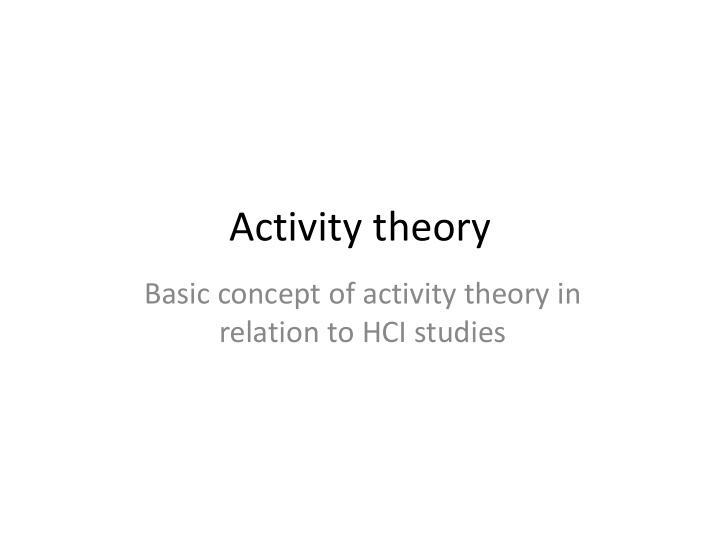



Activity theory Basic concept of activity theory in relation to HCI studies
Origin of Activity theory (AT) • AT originated within Soviet psychology in 1920s by its roots from the cultural – historical school founded by Vygotsky. • Further founded as Activity theory by Leont’ev and his students ( Leont’ev 1974). • Later applied and extended by Scandinavian researchers in mid-1980. AT has continued to develop and expand ever since -> resulting in several generations of AT (Engeström 1987, Kutti 1991, Nardi 1996, Bardram 1998 with more).
Concept of Activity • Activity as the basic unit of analysis – Mediated relationship at the individual level, see figure 1. – Activity in context as the basic structure of an activity, see figure 2. Figure 1: Structure of an individual, Figure 2: The basic structure of an activity mediated action
Concept of activity • The basic idea is that there exists a “fundamental type” of context, which is called an activity. • It is meaningless to study a HCI in-situ without the basic context if aiming to grasp the essence of a phenomenon. • An activity is not given or static, but rather dynamic as its changes and develops over time. • An activity has an active subject (actor), who understands the motive of the activity. This subject can be individual or collective. • An activity has an object and activities can be distinguished according to their objects. • The relationships within an activity are culturally mediated.
Concept of activity • The central relationship within an activity is between the subject and the object. Additionally has Engeström (1987) expanded the activity by adding a third component, the community , to better capture the subject’s context more explicitly. Thus two new relationships are formed; subject-community and community- object. • The relationship between subject and object is mediated by tools i.e. technology. • The relationship between subject and community is mediated by rules i.e. laws and regulations, norms etc. • The relationship between object and community is mediated by the division of labor i.e. negotiations of distribution of tasks, power relationships and responsibility. • Each of mediating terms is historically formed and open to further development.
AT versus ANT Applied within IS – Theory Consept Unit of analysis Agency Localization research field ANT Actor, humans and non- Translations, Socio -technical Humans and non- Networks humans included as a negotiations studies, i.e health humans, symmetri hetrogenious network studies such as hospital studies AT Motivated human Activity system HCI Humans as Activity systems activity individuals, aggregated individuals or as a collection of humans
Recommend
More recommend